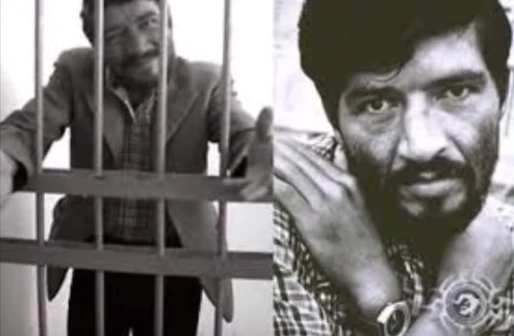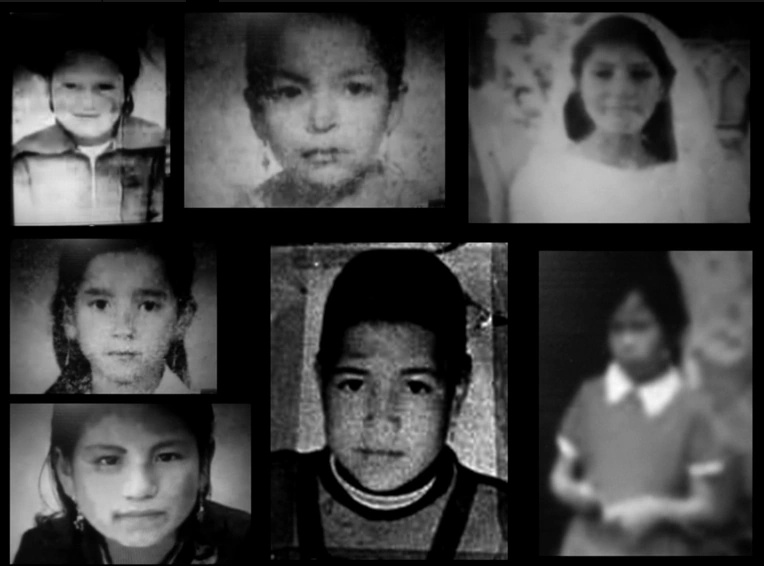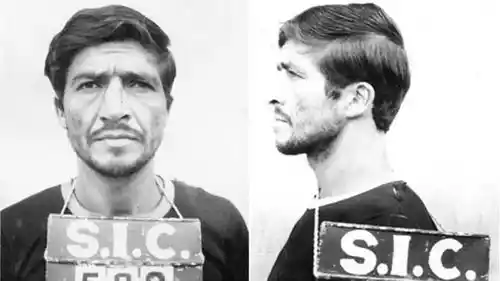Pedro López, known as the “The Monster of the Andes,” is a notorious Colombian serial killer whose terrifying spree spanned Ecuador and Peru. Delve into the chilling story of his reign of terror and uncover the dark details behind his infamous crimes.
Table of Contents
Scars of a Monster: Pedro López’s Abusive and Traumatic Childhood

Pedro Alonso López’s early life was a tragic tale of abandonment and abuse. Born into extreme poverty in Colombia in 1948, his father vanished from his life before he could form any memories. His mother, struggling to provide for her numerous children, ultimately cast him out at a young age, deeming him too difficult to manage.
This rejection thrust Pedro onto the unforgiving streets, where he was left to fend for himself in a hostile environment. Survival became his primary concern, and he quickly learned the harsh realities of life on the margins. Sadly, his vulnerability did not go unnoticed, and he became a target for exploitation—repeatedly subjected to sexual assaults, a traumatic experience that would leave an enduring mark on his psyche.
The psychological toll of these early traumas cannot be overstated. The lack of a stable home, the absence of parental love and guidance, and the repeated violation of his bodily autonomy undoubtedly contributed to his warped sense of self and his distorted views on relationships.
His experiences on the streets fostered a deep-seated mistrust of others, particularly women, and a growing resentment towards society. The constant fear and uncertainty he experienced during this period had a profound impact on his developing brain, potentially leading to long-term psychological and emotional damage.
In addition to the psychological trauma, Pedro’s experiences on the streets exposed him to violence and aggression. He witnessed and experienced acts of violence on a regular basis, which desensitized him to violence and made him more likely to engage in it himself. The constant struggle for survival and the lack of any positive role models in his life also contributed to his development of antisocial behavior.
As Pedro grew older, the seeds of violence and misogyny sown in his youth began to take root. The anger and pain he harbored found an outlet in increasingly disturbing behavior. He developed a warped sense of power and control, seeking to inflict upon others the pain and suffering he had endured. This twisted path would eventually lead him to become one of the most prolific serial killers in history, his actions forever tainted by the trauma of his early life.
The Monster’s First Prey: The Murder of Maria Emma
The year was 1969, and Pedro was a troubled young man hardened by a life of poverty and abuse. Filled with rage and resentment, he sought to unleash his pent-up anger upon the world, and tragically, a 12-year-old girl named Maria Emma would become his first victim.
Maria was a vulnerable child living in the slums of Bogotá, Colombia, leading a difficult life, similar to Pedro’s own upbringing, filled with hardship and deprivation. However, her life was cut tragically short when she crossed paths with the budding serial killer.
Pedro lured the young girl away from her family, using his charm and promises to manipulate her trust. He then took her to a secluded location, where he brutally raped and strangled her, marking a turning point in his life. It was the moment he crossed the line from petty criminal to cold-blooded killer. The act of taking a human life, of extinguishing the light of a young girl’s future, seemed to awaken a dormant evil within him. He had tasted blood, and the experience left him craving more.
The tragic death of Maria went largely unnoticed at the time. Her disappearance was just another statistic in a city plagued by poverty and violence. However, for Pedro, it was a pivotal moment, a morbid initiation into a world of darkness from which there would be no return. He had discovered a twisted pleasure in inflicting pain and suffering, and the memory of Maria Emma would forever haunt his dreams, fueling his insatiable thirst for violence.
Her murder was the first in a long and gruesome series of crimes that would earn Pedro the chilling moniker of “The Monster of the Andes.” It was a tragic beginning of a campaign of violence that would span multiple countries, including Ecuador, Peru, and Colombia, claiming the lives of hundreds of innocent girls.
The Monster’s Misogyny: Pedro López’s Early Adult Life
By the time Pedro reached his early twenties, the streets had hardened him, turning him into a surviving predator. His distorted worldview, fueled by abuse and neglect, manifested in criminal behavior and a growing fascination with violence.
In 1969, at the age of 21, his criminal activities caught up with him after he was arrested for car theft, a seemingly minor offense that would prove to be a pivotal moment in his life. Imprisonment exposed him to a new level of brutality, where he became the victim of repeated sexual assaults by fellow inmates. This horrific experience, mirroring the traumas of his childhood, ignited a fire of rage within him. Driven by a twisted sense of vengeance, Pedro retaliated against his attackers, killing them with a makeshift knife.
This act of violence, while born out of self-defense, awakened a darker impulse within him, fueling his growing hatred of women. He discovered a perverse pleasure in inflicting pain and suffering, a disturbing realization that would shape his future actions.
Upon his release from prison, his criminal behavior escalated to preying on young girls, luring them with promises of gifts or money before brutally assaulting and murdering them. His victims were primarily indigenous girls from impoverished backgrounds, reflecting his own marginalized upbringing. He targeted those he perceived as vulnerable, seeking to exert power and control over them in a twisted attempt to compensate for the powerlessness he had experienced in his own life.
Pedro’s misogynistic beliefs manifested a deep-seated hatred of women, describing them as “dirty” and “untrustworthy,” expressing a perverse satisfaction in causing them pain and suffering. His actions were not simply motivated by a desire to kill, but also by a desire to punish and degrade women. His misogyny was not just a personal belief system; it was a driving force behind his crimes, justifying his violence against women in his twisted mind.
His modus operandi was chillingly efficient, as he would often abduct his victims in broad daylight, taking advantage of their trust and innocence. Afterwards, he would take them to secluded locations, where he would subject them to horrific acts of sexual violence before strangling them to death. The sheer brutality of his crimes shocked even seasoned investigators.
As Pedro’s violent rampage continued, the number of missing girls in the region began to rise alarmingly. However, due to the marginalized status of his victims and the lack of resources dedicated to investigating their disappearances, his crimes went largely unnoticed for years. He exploited this societal indifference, preying on the most vulnerable members of society with impunity.
His early adult life was a dark and disturbing chapter in a story that would ultimately become one of the most horrifying tales of serial murder in history. It was a period marked by escalating violence, a growing obsession with death, and a complete disregard for human life. The seeds of evil sown in his childhood had blossomed into a monstrous reality, setting him on a path of destruction that would leave a trail of broken lives in its wake.
Unmasking the Monster of the Andes: The Investigation and Capture of Pedro López
In 1979, a wave of disappearances of young girls swept across Ecuador and Peru, leaving communities terrified and law enforcement scrambling for answers. However, a series of events in 1980 would finally lead to unmasking Pedro.
In the city of Ambato, Ecuador, a devastating flood in 1979 unearthed a mass grave containing the remains of four young girls. This grim discovery, coupled with the alarming rate of disappearances, prompted a more thorough investigation. Local authorities, aided by international organizations, began to connect the dots, realizing that they were dealing with a serial predator.
Pedro’s violent spree reached a chilling climax when he attempted to abduct 12-year-old Marie Poveda, the daughter of Carvina Poveda. Marie and her mother were on their way to the market when Pedro, driven by his insatiable thirst for violence, targeted the young girl. He snatched her from her mother’s side and attempted to flee the scene. The terrified screams of Carvina alerted nearby merchants, who quickly intervened and apprehended Pedro.
During his interrogation, he initially remained silent, but eventually confessed to a series of horrific crimes that shocked the investigators to their core He led authorities to a mass grave containing the remains of 53 young girls, victims of his brutal assaults and murders.

This discovery sent shockwaves through Ecuador and the world. The young victims had been systematically targeted, abducted, raped, and murdered by a predator who had operated with impunity for years.
His arrest and confession brought a sense of closure to the grieving families, but it also raised questions about how Pedro had managed to evade capture for so long. The investigation revealed a systemic failure on the part of law enforcement agencies, who had overlooked the disappearances of marginalized girls and failed to connect the dots sooner.
The Monster’s Day in Court: The Trial and Sentencing of Pedro López
In 1980, Pedro, the self-confessed “Monster of the Andes,” faced the Ecuadorian justice system for his horrific crimes. The trial was a landmark case, not only due to the sheer scale of his atrocities but also because of the challenges it posed in prosecuting a serial killer who had operated across multiple countries.
Pedro’s trial took place in Ambato, Ecuador, the city where he was apprehended. The evidence against him was overwhelming, including his detailed confessions to over 300 murders, leading authorities to numerous gravesites. Other evidence includes the discovery of the mass grave containing the remains of his victims, and testimonies from witnesses who had survived his attacks.
Despite the overwhelming evidence, his legal defense team attempted to argue that he was insane and therefore not responsible for his actions. They pointed to his traumatic childhood, his history of mental illness, and the brutalization he suffered in prison as contributing factors to his violent behavior.
The prosecution, however, argued that Pedro was fully aware of his actions and had meticulously planned and executed his crimes. They presented evidence of his methodical approach to selecting and abducting victims, his efforts to conceal his crimes, and his lack of remorse during his confessions.
After a lengthy trial, the court found Pedro guilty of the murders of 110 young girls in Ecuador. However, due to the limitations of Ecuadorian law at the time, he was only sentenced to 16 years in prison, the maximum sentence allowed under the country’s penal code.

The verdict and sentence sparked widespread outrage both in Ecuador and internationally. Many felt that justice had not been served and that Pedro’s punishment was far too lenient considering the magnitude of his crimes. The case highlighted the inadequacy of the legal system in dealing with serial killers and the need for stricter laws to protect vulnerable populations.
In 1994, Pedro was released from prison after serving 14 years of his sentence, having been granted early release for good behavior. His release sparked further outrage and fear, as many believed he would continue to pose a threat to society. He was deported to Colombia, where he was briefly institutionalized in a psychiatric facility before being released under supervision. Pedro’s whereabouts remain unknown since his release, raising concerns that he may have resumed his murderous activities.
Legacy of Evil
Pedro Alonso López’s case is a stark reminder of the depths of human wickedness and the enduring impact of childhood trauma. His victims, their families, and the communities he terrorized continue to grapple with the devastating consequences of his actions. Pedro’s legacy serves as a chilling reminder of the importance of vigilance and the need for continued efforts to protect vulnerable populations.
Additional “Serial Killers” Crime Stories
- Luis Alfredo Garavito: The Serial Beast
- 5 Infamous Serial Killers That Were Never Caught
- The Bloody Legacy Of Bonnie And Clyde
- The Chilling Case of Ben Doberman Serial Killer
Read “PEDRO ALONSO LÓPEZ: THE BIOGRAPHY of the most series killer of all time”

Real Check Print presents a captivating portrait of one of history’s most chilling figures: PEDRO ALONSO LÓPEZ
Delve into the haunting life of Pedro Alonso López, the infamous “Monster of the Andes,” and uncover the secrets of this elusive serial killer who terrorized South America.
This gripping biography explores the darkness that consumed López, his twisted motivations, and the relentless pursuit of justice. Prepare to be captivated by a true crime story that will leave you breathless.
Unravel the mystery that shocked the world. Get your copy today and step into the shadows with Pedro Alonso López!
FAQs
How does Pedro López compare to other notorious serial killers?
Pedro López is often compared to other prolific serial killers like Ted Bundy or Jeffrey Dahmer. However, what sets him apart is the staggering number of his alleged victims, which, if confirmed, would make him one of the most lethal serial killers in history. Unlike many others, his crimes spanned multiple countries, making his case particularly complex.
How many victims did “The Monster of the Andes” claim to have killed?
Pedro Alonso López claimed to have killed over 300 young girls across Colombia, Ecuador, and Peru. He was convicted of 110 murders, but authorities believe the true number of his victims could be much higher.
What impact did the Monster of the Andes have on society?
The Monster of the Andes instilled widespread fear in the Andean region and beyond, leading to increased awareness of child abductions and the dangers posed by serial killers. His case also highlighted flaws in the judicial and penal systems of the countries involved.